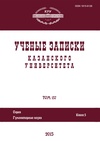«Беатусы» как источник по истории исламо-христианского межкультурного взаимодействия в средние века
“The Beatus” as a Source of the History of Islamic and Christian Intercultural Relations in the Middle Ages
Author(s): Natalja Anatolevna ShadrinaSubject(s): Christian Theology and Religion, Library operations and management, Islam studies, Comparative Studies of Religion, Philology
Published by: Казанский (Приволжский) федеральный университет
Keywords: Islamic Christian dialogue; Beatus of Liebana; medieval illuminated manuscripts; “The Beatus”; mosarab culture; medieval Spain;
Summary/Abstract: The problems of the Islamic and Christian intercultural relations on the Iberian Peninsula during the Middle Ages were studied. The territory is characterized by unique syncretic cultural complexes that developed under the Muslim rule, thereby demonstrating that a dialogue between the two cultures is possible. The focus of the paper is the culture of the Mozarabis, the Arabized part of the Christian population of the peninsula, which perceived, in one way or another, the Arab Muslim culture. The research concerns the most striking manuscripts to show the Mozarabic culture specificity: the illuminated manuscript “The Beatus”, the lists of “The Commentary on the Apocalypse” created by the monk Beatus of Liebana. The influence of the Arab Muslim artistic tradition on the pictorial program of manuscripts was found through the analysis of the illustrations of the Beatus lists created in the 10th century. It was concluded that the illustrations of “The Beatus” provide no evidence of an acute religious confrontation between the Muslims and Christians on the Iberian Peninsula during the period under study; the interest in the book of the Apocalypse was caused rather by common eschatological expectations in the Christian world. On the other hand, the borrowings from the Arab Muslim artistic tradition, which can be clearly seen in the pictorial program of “The Beatus”, were probably relatively spontaneous and had no religious overtones.
Journal: Ученые записки Казанского университета. Серия Гуманитарные науки
- Issue Year: 160/2018
- Issue No: 6
- Page Range: 1374-1383
- Page Count: 10
- Language: Russian

